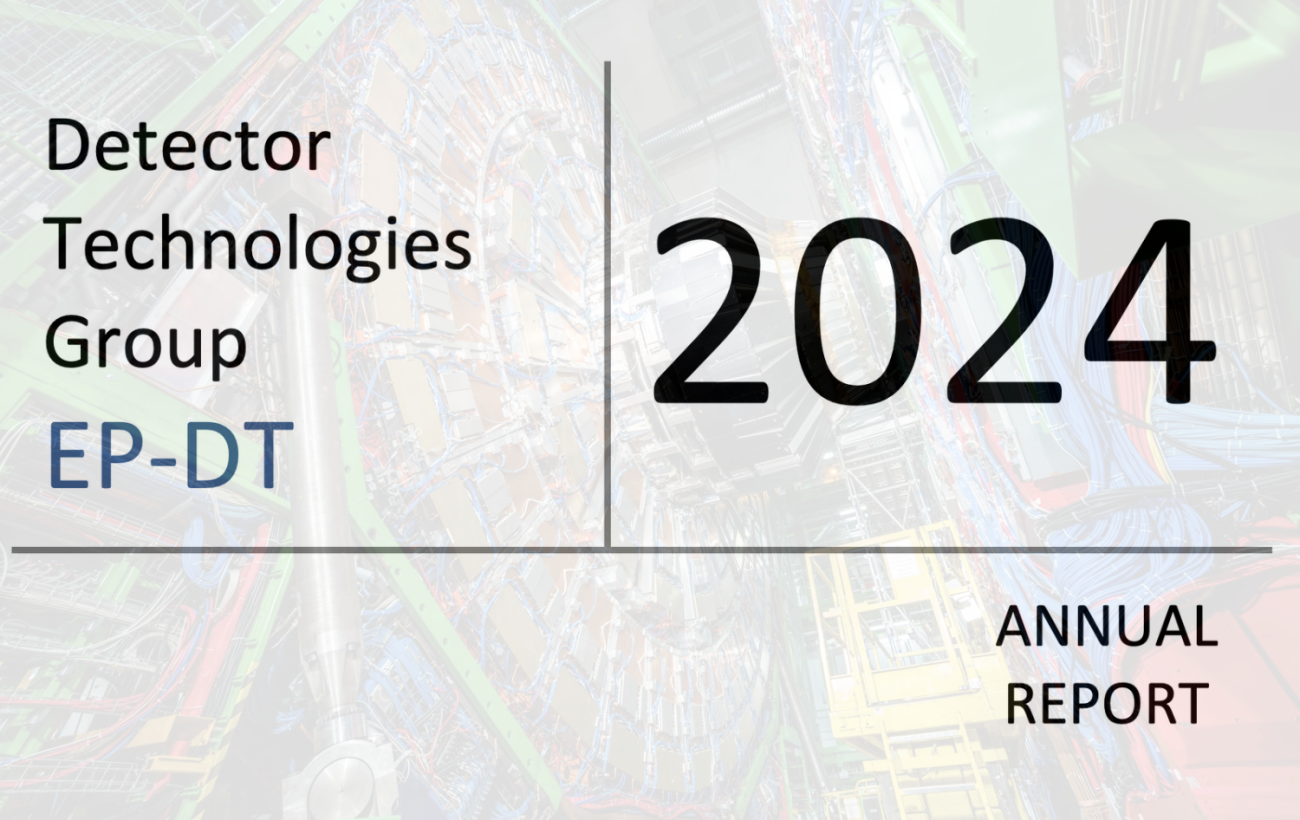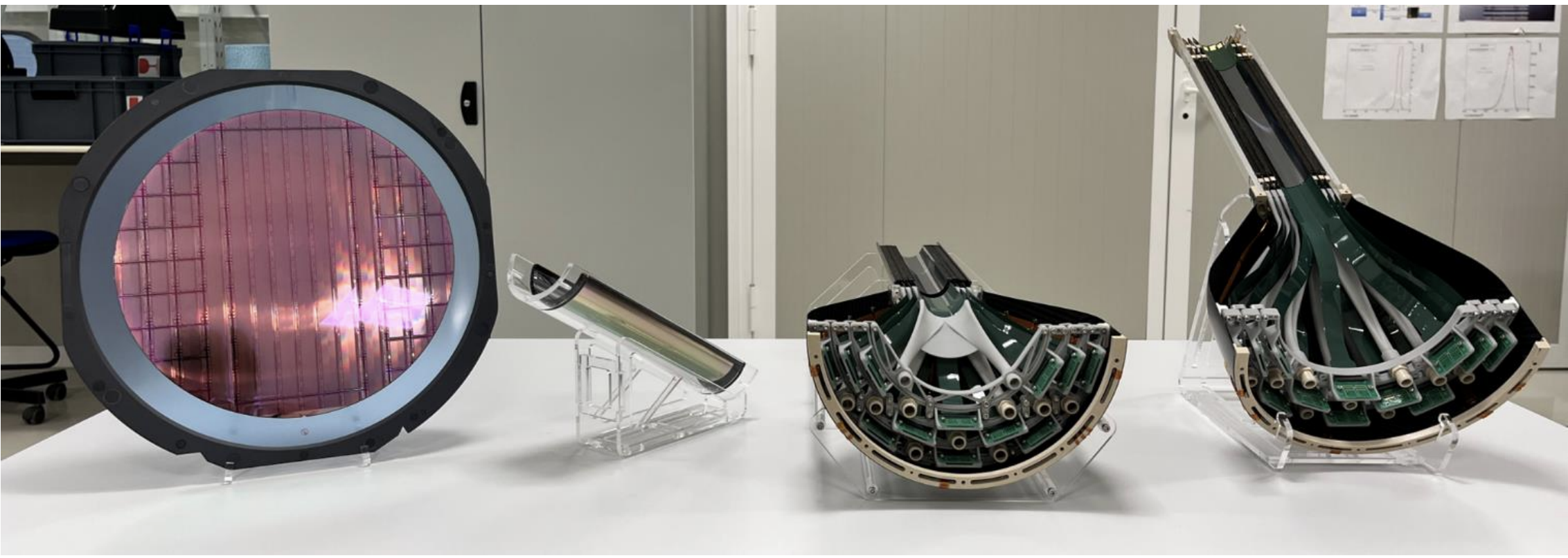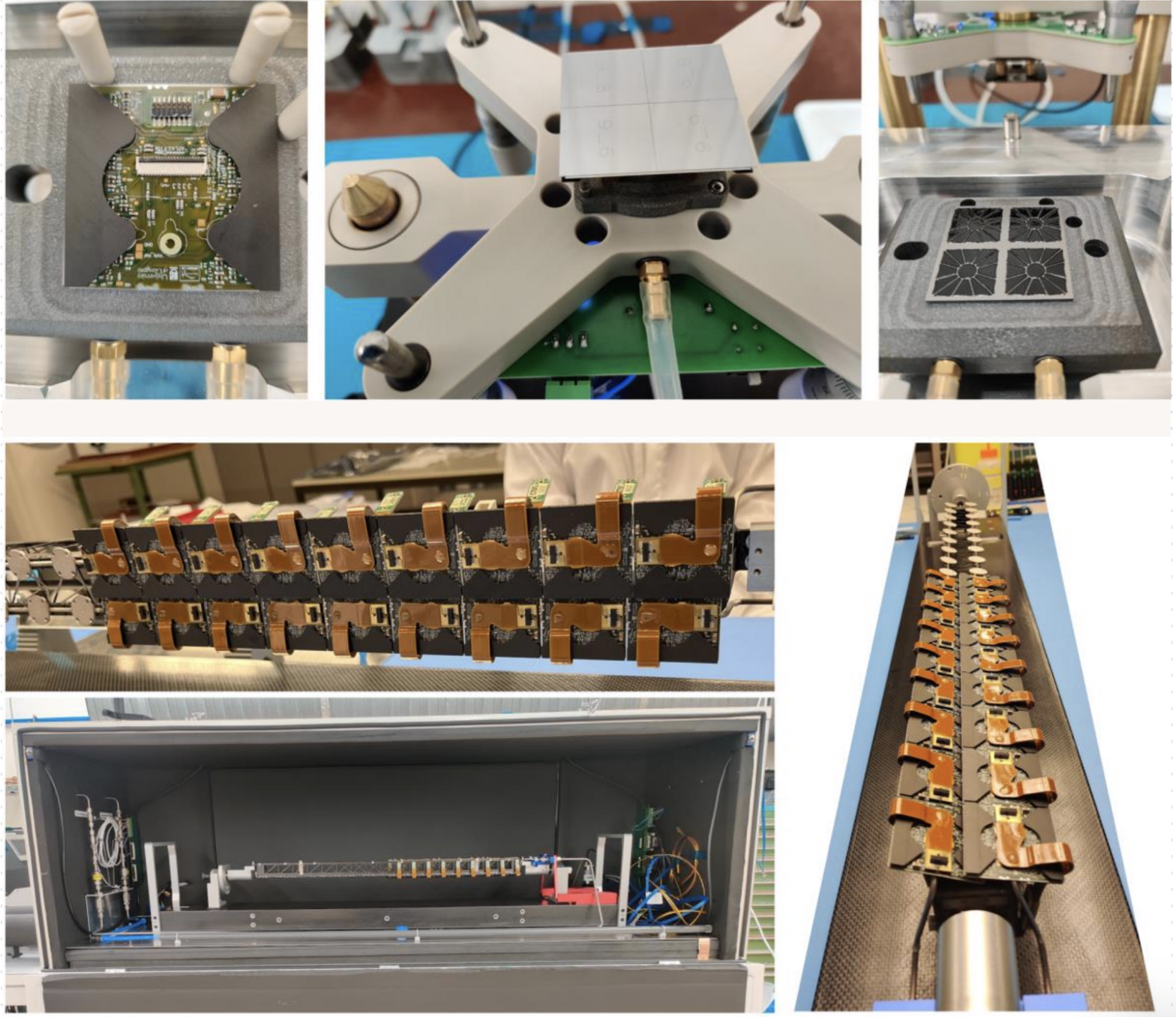Shaping Detector Innovation: Highlights from CERN’s EP-DT Group Annual Report

The Detector Technologies (EP-DT) group has played a vital role in 2024 in advancing experimental capabilities across CERN’s LHC and non-LHC programmes. As outlined in the group’s recently published annual report, their contributions span from detector construction and integration to critical R&D on enabling technologies, providing state-of-the-art infrastructure, and operating services essential to the physics programme.
A Pillar of Detector Development and Operation
Structured into seven specialized sections, the EP-DT group combines expertise in mechanics, cooling, control systems, and detector technologies to support CERN’s experiments. In 2024, 52% of staff time was devoted to collaborative projects, while 35% supported service activities and 7% focused on R&D.
From engineering carbon-fibre detector supports to operating irradiation facilities, the group’s work covers the full detector lifecycle. Several members lead or contribute to strategic initiatives within the Detector R&D (DRD) collaborations—advancing technologies in silicon and gas detectors, lightweight mechanics, and sustainable cooling systems.
Driving Major Detector Upgrades at the LHC
The EP-DT group was deeply involved in detector upgrades planned for LS3 across all four LHC experiments — a crucial phase in preparing CERN’s experiments for the demands of the High-Luminosity LHC (HL-LHC) era.
For ALICE, the group led the mechanical design of ITS3, a new vertex detector employing thin, bendable Monolithic Active Pixel Sensors. In 2024, prototypes integrating air cooling and ultra-light carbon foam supports were validated, while integration studies advanced with support from the EN-CV group. Forward-looking contributions also supported early design and automation concepts for the future ALICE 3 experiment.

ALICE ITS3 prototypes integrating thin wafer-size MAPS sensors. (From left to right): a thin 12-inch pad wafer; a curved half-layer sensor; an ALICE ITS3 prototype integrating services on one side of the sensor; and a second ALICE ITS3 prototype with services integrated on both sides.
In ATLAS, CERN’s role as a module production site for the ITk Outer Barrel reached a milestone with over 100 pixel modules assembled. The newly refurbished ISO8 cleanroom enabled full testing workflows, from bonding and parylene coating to electrical validation. Tools like a production simulation model and DAQ monitoring system streamlined operations as the project scaled toward full production.
Mechanically, the EP-DT team produced key components for the ITk Pixel Outer Barrel, including trusses, carbon rings, and evaporators. A successful system test of a pre-production loaded longeron confirmed design and assembly methods. Integration tooling and global support structures were also validated through full-size prototypes and simulations, culminating in a successful design review.
Top: Cell Loading process at CERN, showing the preparation and gluing of the first pre-production pixel modules onto bare local support cells. Bottom: Assembly and testing of the first pre-production longeron at CERN, featuring eighteen Japan-built pixel quad modules integrated into two serial powering chains and tested inside a dedicated environmental enclosure.
For CMS, the group advanced the production of tilted carbon-fibre rings for the TBPS sub-detector, achieving 40% of the final quantity by year’s end. Precision part production and manual assembly techniques ensured consistent quality. Design and delivery of complex components like titanium cooling pipes and carbon-fibre front panels for the TB2S sub-detector also progressed, with deliveries to international partners ongoing.
Production of cooling plate assemblies (left) and cooling pipes (right) for the TBPS Rings. These components are part of the Tilted Rings developed for the CMS Tracker’s Phase 2 upgrade, designed to support Pixel-Strip (PS) modules and ensure efficient thermal management via two-phase CO₂ cooling at –35°C. In 2024, the DT group reached full production speed, contributing to the goal of delivering 83 Rings by mid-2026.
The CMS High Granularity Calorimeter (HGCAL) project benefited from EP-DT’s leadership in silicon sensor QA. Nearly half of the 26,000 ordered wafers were delivered in 2024, and CERN played a central role in analyzing vendor data, validating partial sensors, and characterizing radiation tolerance through annealing campaigns. These efforts earned recognition within CMS, including a 2023 CMS award for Leena Diehl.
The group also led developments for the LHCb ECAL Upgrade II, including prototypes of SpaCal modules with novel fibre-based scintillators and precision mechanics. Extensive R&D was also carried out for the IRIS vertex detector concept in ALICE 3 and for the TORCH and RICH upgrades in LHCb.
In 2025, the EP-DT-CO group continued to support the mechanical systems and operation of the LHCb VELO detector. In July, a defect in the belt of the motion system led to a failure in the VELO closing mechanism. R. Dumps carried out a timely intervention, replacing the belt and modifying the tensioning system to accommodate the different length of the spare crate. Thanks to the swift response, no data was lost.
During the YETS 2024/2025 period, EP-DT-CO also supported the repair of a secondary vacuum leak that had been identified earlier in 2024. A custom electronics holder was designed and built to streamline the disconnection, reconnection, and recommissioning process, significantly reducing intervention time. The repair was successful, and the temporary shims that had kept the detector slightly retracted were finally removed.
Left: The optoelectronic board of the A-side VELO for the LHCb experiment were placed on a dedicated support designed by EP-DT-CO to not have to disconnect the many optical fiber during the YETS intervention where the A-side was fully opened. Right: a split view of the conceptual design for the LHCb VELO upgrade 2. Four quarter made of module whose sensor are in the primary vacuum are coupled by a “diaphragm-like” motion system that allows the VELO to open and close. The design intends to make intervention and maintenance easier than in the present implementation.
Notably, the group supported innovations in experiments like FASER—where new compact scintillator systems were designed and installed rapidly in response to increased muon backgrounds—and LHCb, with significant upgrades to the condensation prevention system of the SciFi tracker and development for the VELO Upgrade II. Preparations also advanced for the proposed FASER2 detector, with contributions to layout design, tracking, and veto systems.
The full FASER preshower including the scintillators were installed in the YETS2024/25 and are ready for beamThe 4 small metal package photomultipliers are wrapped in aluminum tape and visible in the center of the photo.
Enabling Impact Beyond the LHC
In addition to their central role in LHC upgrades, EP-DT continued to support a wide range of non-LHC experiments. In CLOUD, the group played a key role in commissioning the new CHARGE2 generator and adapting infrastructure for new beam tests. Two doctoral students hosted in DT coordinated run operations and development activities, including FLOTUS, a tool for cloud formation studies.
For NA62, the group supported detector integration and DAQ system upgrades, while in COMPASS/AMBER, EP-DT contributed to mechanical support and infrastructure.
These efforts demonstrate EP-DT’s versatility and deep integration into CERN’s broader physics programme, providing tools and expertise that are critical across diverse scientific frontiers.
A Critical Infrastructure: Cooling, Controls, and Services
The Fluidic Systems section transitioned into full production mode for the new CO₂ cooling systems for ATLAS and CMS, following years of R&D and prototyping. By the end of 2024, multiple large components—including pumping units and accumulators—were successfully installed underground with high precision.
Crucially, the team also pursued several initiatives aimed at reducing the environmental footprint of detector systems. R&D on alternative gas mixtures advanced significantly, with long-term studies on HFO-based gases for RPC detectors and promising replacements for traditional greenhouse gases like R134a, CF₄, and SF₆. Notable milestones included the operation of the first R134a recuperation plant at CMS and the design of new C₄F₁₀ recovery systems for LHCb. These efforts represent important steps toward more sustainable detector technologies at CERN.
Control and safety systems were maintained and upgraded across experiments by the Detector Interface section. Their work included deployments for LHCb, CLOUD, and the Neutrino Platform, as well as the ongoing DSS upgrade for LHC detectors. DAQ support extended to SHIP, FASER, and DUNE.
Supporting R&D and Cross-Experiment Synergies
Throughout the year, the group continued to host and operate central facilities such as the Departmental Silicon Facility, the Bond Lab, irradiation centres (IRRAD, GIF++), and the Scintillator and Thin-Film labs. These enabled both project-specific and exploratory R&D efforts, including sensor development, gas studies with eco-friendly mixtures, and ultra-light mechanics.
In December 2024, the GIF++ facility marked its 10th anniversary since the commissioning of its irradiator in 2014. Over the past decade, GIF++ has become a vital platform for the development and testing of new muon gas detectors, particularly in support of the LHC experiments. Initially designed for a 10-year operational lifespan, the facility has seen sustained—and growing—demand, with 22 active user groups, most of which are affiliated with the LHC collaborations. Reflecting this continued relevance, a decision has been made to extend the lifetime of GIF++ to support future R&D activities.
To ensure long-term reliability, a new 10-year maintenance contract for the irradiator has been negotiated and signed. In January 2025, comprehensive curative and preventive maintenance work was carried out, covering both the irradiator’s mechanical components and its control electronics.
Planning efforts in 2025 have focused on sustaining and expanding operations for the coming years. Several limiting factors have been identified, including the challenge of uneven shadowing for setups positioned farther from the irradiator, and constraints in irradiation and service space—particularly for additional gas mixture racks and monitoring equipment. Following the model of the 2019 bunker extension, a new working group has been established to explore the feasibility of expanding the irradiation area sideways by repurposing part of the current preparation space.
Concept of an extended irradiation area. Feasibility study completed and finalized in 2024. The extension of the gas balcony was approved, resources allocated to it and will take place during LS3.
The group’s contributions are also integral to CERN’s broader R&D strategy, particularly through their active involvement in the EP R&D programme. The recently published EP R&D Annual Report 2024 provides further insight into these activities and the technologies under development.
Looking Ahead

